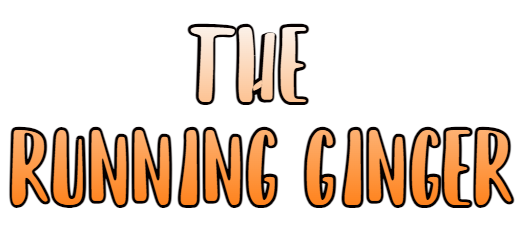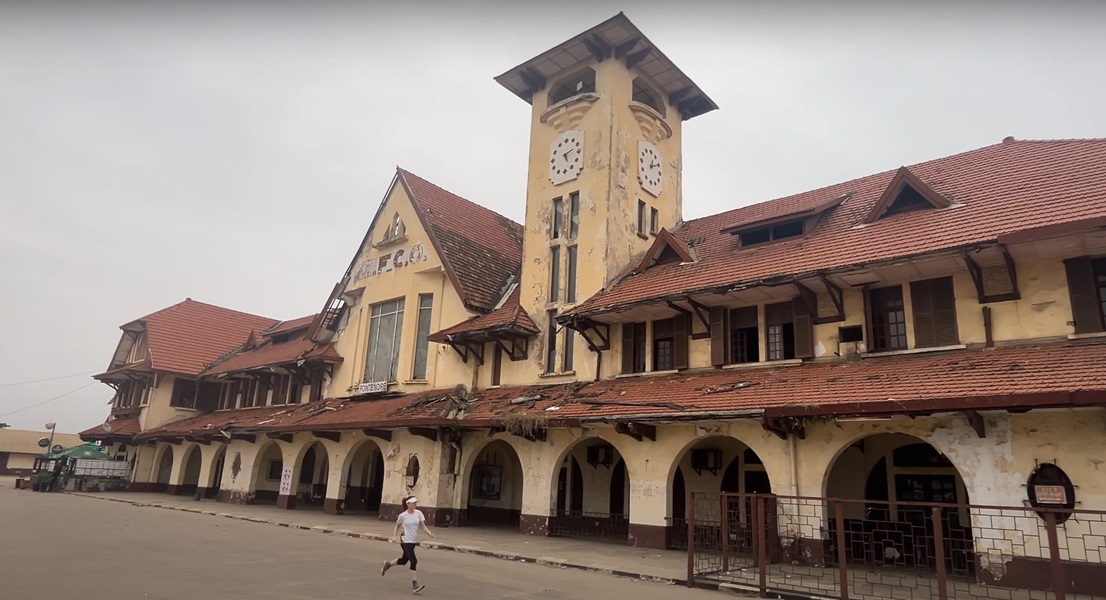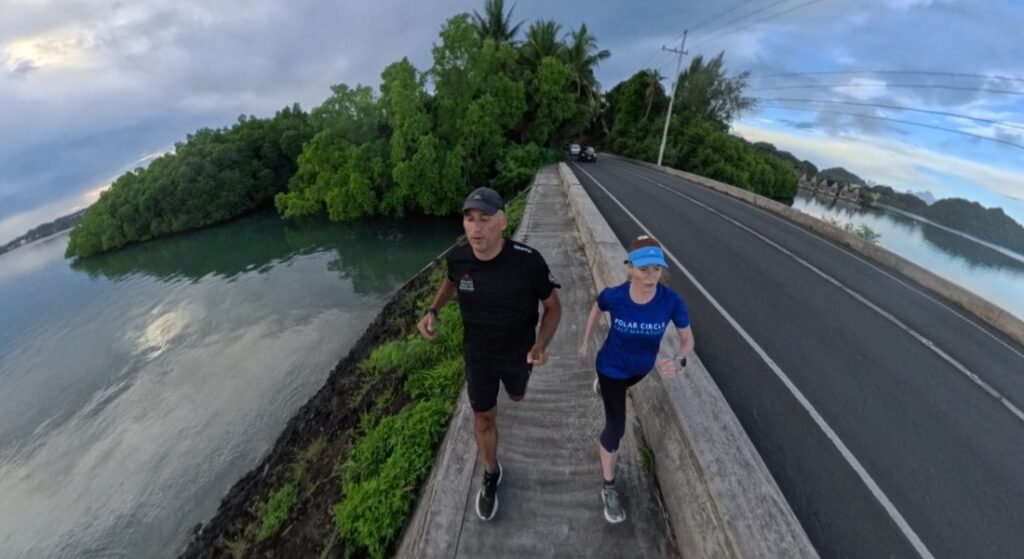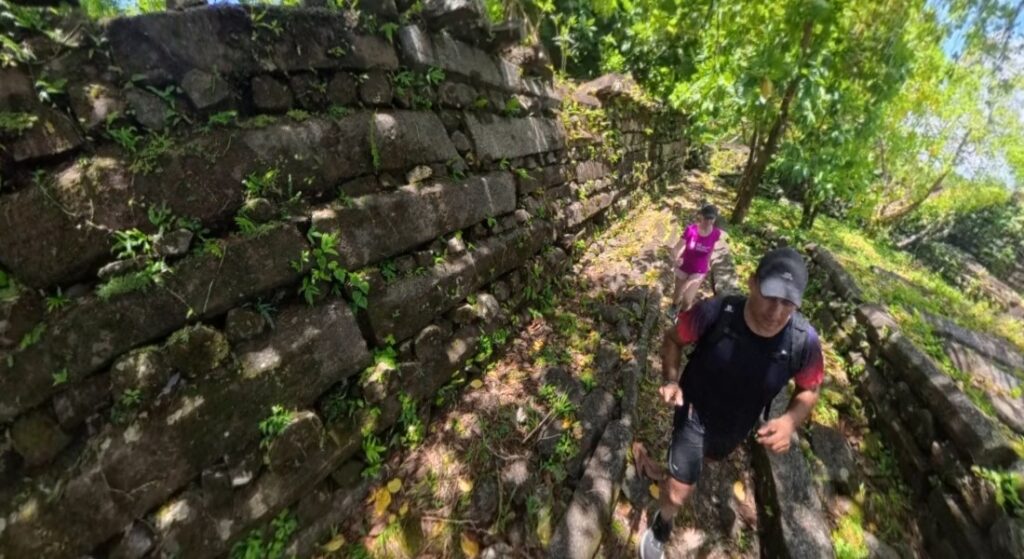10th and 11th of June 2025. 6,5k in Pointe Noire, Republic of the Congo.
A couple of unusual runs through a monumental abandoned railway station which spoke of other times, and along a wild coastline in Pointe Noire: an unforgettable run on a beach of wild beauty while the waves roared.
Why not?
Last year, we were scheduled to visit Brazzaville during our adventurous trip to the Democratic Republic of the Congo, but we failed to cross the river as … well, things got complicated once we were in Kinshasa.
So when I was designing our trip to Africa for 2025, I realised there were direct flights from Libreville (in Gabon) to Pointe Noire, and I remembered our guide in DRC mentioning “Pointe Noire is supposed to be amazing” so I thought… why not?!
Why not indeed? I did a google search and found out that I really wanted to visit the Gorges of Diosso!
(And, btw, the ‘direct’ flights were later changed to stop at Brazzaville, but… who cares?)
TLDR; “too long, didn’t read”
- I just want to run! Take me to RUN.
- I have 1 minute. Take me to USEFUL INFORMATION.
- Running is my excuse for travelling. Take me to TRIP.
- Running is my excuse for eating. Take me to CARBOLOADING.
- I want to know what to read in the plane. Take me to ONE BOOK.
🌍 The trip 📷: What to see in Pointe-Noire in a couple of days
🇨🇬 The visa 🛂
It is NOT easy to get a tourist visa to Republic of the Congo. Word to the wise: start the process at least 3 months before the trip.
We were getting visas for a few other countries, like Gabon, or Sao Tome, or Uganda… and all could be done online. But not with our friends the congolese, as we painfully learnt the year before.
Because I had tried the year before, I knew that Rebublic of the Congo – Brazzaville does not have an embassy in Spain, so we had to send our passports to Paris!!!
You will need two photographs, a Letter of Invitation, copy of the flight details, your vaccination passport, etc, etc.
We received the beautiful stamp, extending a whole page of our passports, three weeks before leaving. Yay!!
Getting there – not as easy as it would seem!
The trip started with an anecdote.
We flew from Ruanda and when we tried to check in, they wouldn’t let us. The check-in agent called her boss and they asked to see our “Republic of Congo” visa multiple times, our return ticket to Spain even more times, and asked if we were going to work there -?! or what we were going to do. We kept saying “Tourism, 4 days”, but apparently we didn’t seem convincing. We finally understood what was really going on when the “boss guy” asked: “Kinshasa?”…
Ah!
They thought that we were travelling to the DRC! 😇 Of course, the two countries are at war!!
So we said “Congo-Brazzaville” and then it was sorted!! 🥲 Lesson learnt: Brazzavilleeee, Brazzavilleee!!
A long journey…
Because our original flight had been cancelled, we had to take two flights which actually were 4, since the Ethiopian Airlines planes made ‘technical stops’ to drop and pick up passengers at Entebbe and Brazzaville. All in all, more than 12 hours flying (a direct flight from Kigali to Pointe-Noire, had it existed, wouldn’t have been more than 3h!)
It was a little bit too much… 😅 More like an “express tour” of East and Central African airports 🤣, but hey… what could we do?
This way we got to see the River Congo in Kinshasa / Brazzaville, one year later!
Pointe Noire
Pointe-Noire is the second-largest city in the Republic of the Congo and its primary economic hub, as our guide, Nel, promptly explained.
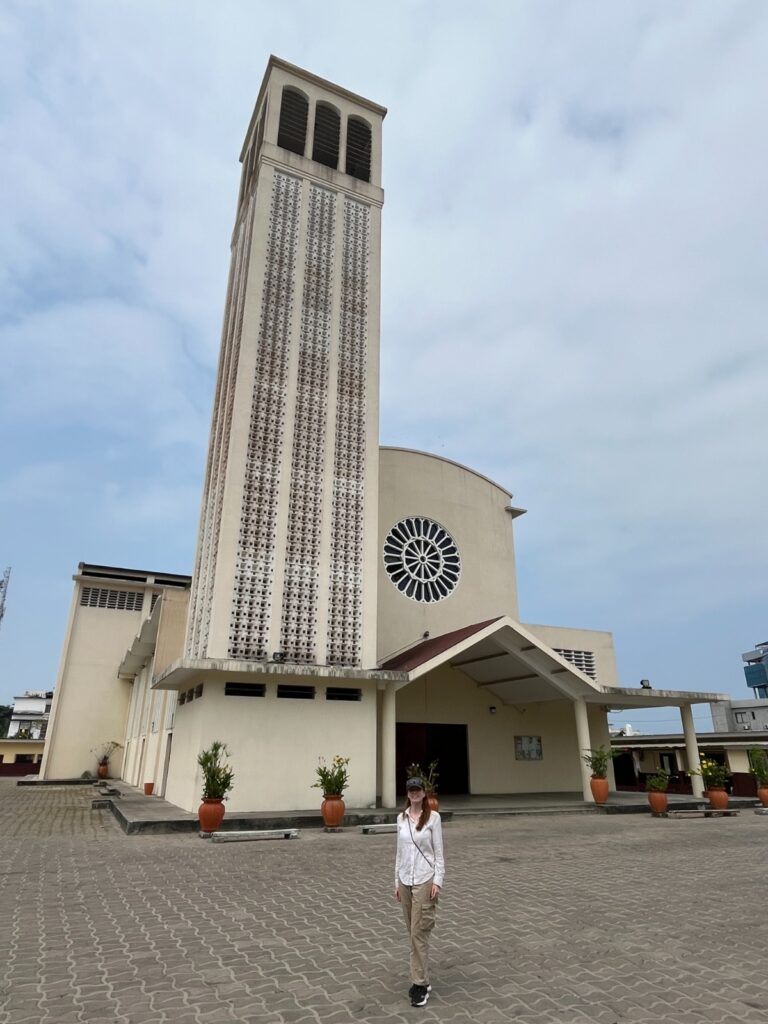
Located on the Atlantic coast, it plays a crucial role in the country’s oil and shipping industries. Its harbour
It’s known for its vibrant markets, French colonial architecture, and multicultural population. We arrived on the 9th of June, “Pentecost” (when catholics celebrate the coming of the Holy Spirit), so the first day we did not see the vibrant markets yet, but we did see the French Colonial architecture…. specially its railway station!
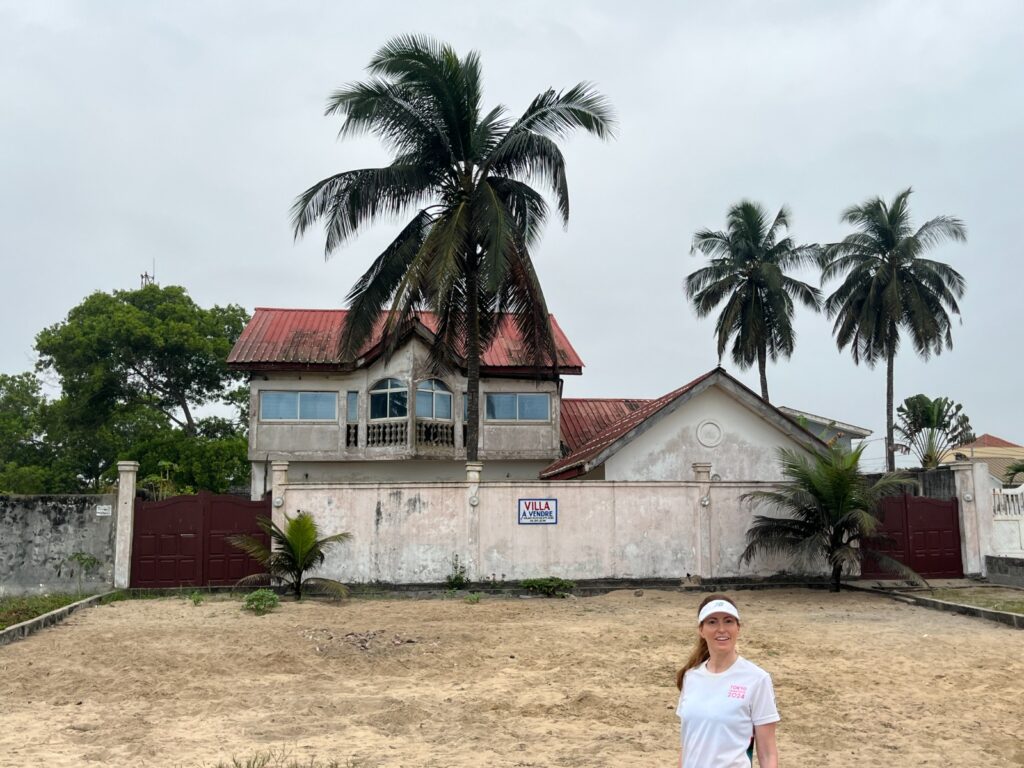
Pointe-Noire Railway Station (Gare de Pointe-Noire)
What an impression made on me!
There it stood, in the scorching sun, abandoned, decadent… yet beautiful and picturesque.
I found this blog post about it, with old pictures. We thought that it was not in operation anymore, but Nel explained it is still working for cargo trains (no passengers).
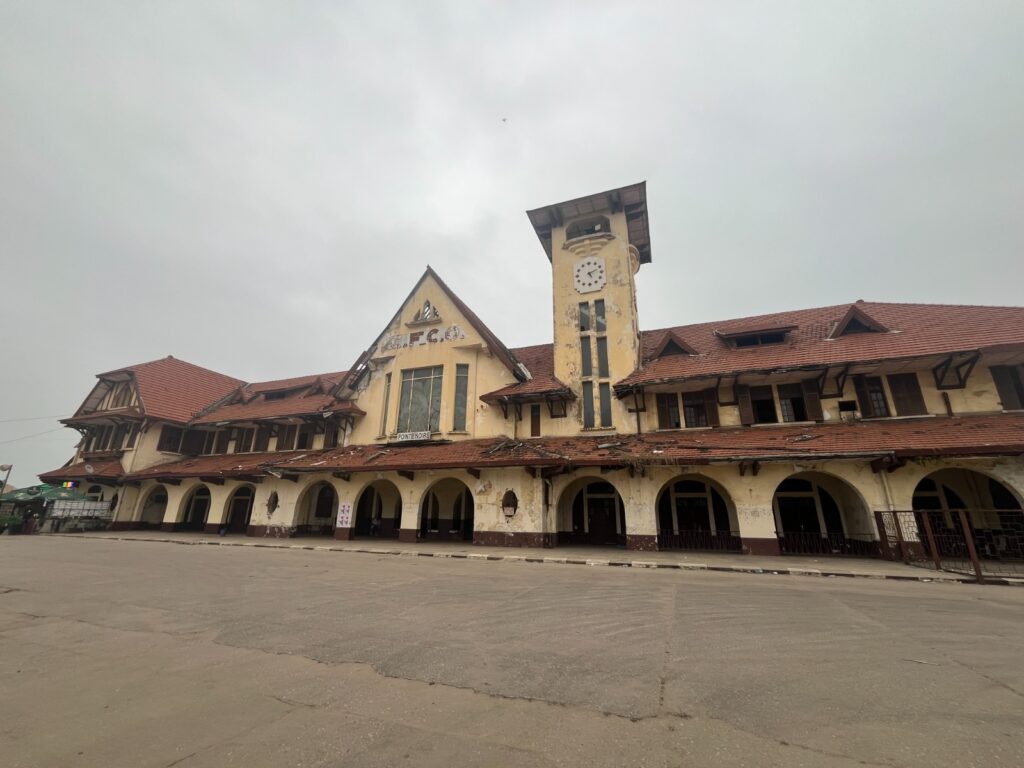
The railway station in Pointe-Noire is the western terminus of the Congo-Ocean Railway (Chemin de fer Congo-Océan, CFCO), which connects Pointe-Noire to Brazzaville, the capital city, spanning across dense forests, rivers, and hilly terrain.
Built during the French colonial era (completed in 1934), the station and railway played a key role in colonial trade and continue to serve as a vital transport link for passengers and freight.
Architecturally, the station retains a colonial-era charm with classic designs and has historical significance in the country’s development.
Côte Sauvage (Wild Coast)
Later we enjoyed lunch in the Côte Sauvage, the name for the stretch of wild, undeveloped beach along the Atlantic Ocean, just outside of central Pointe-Noire.
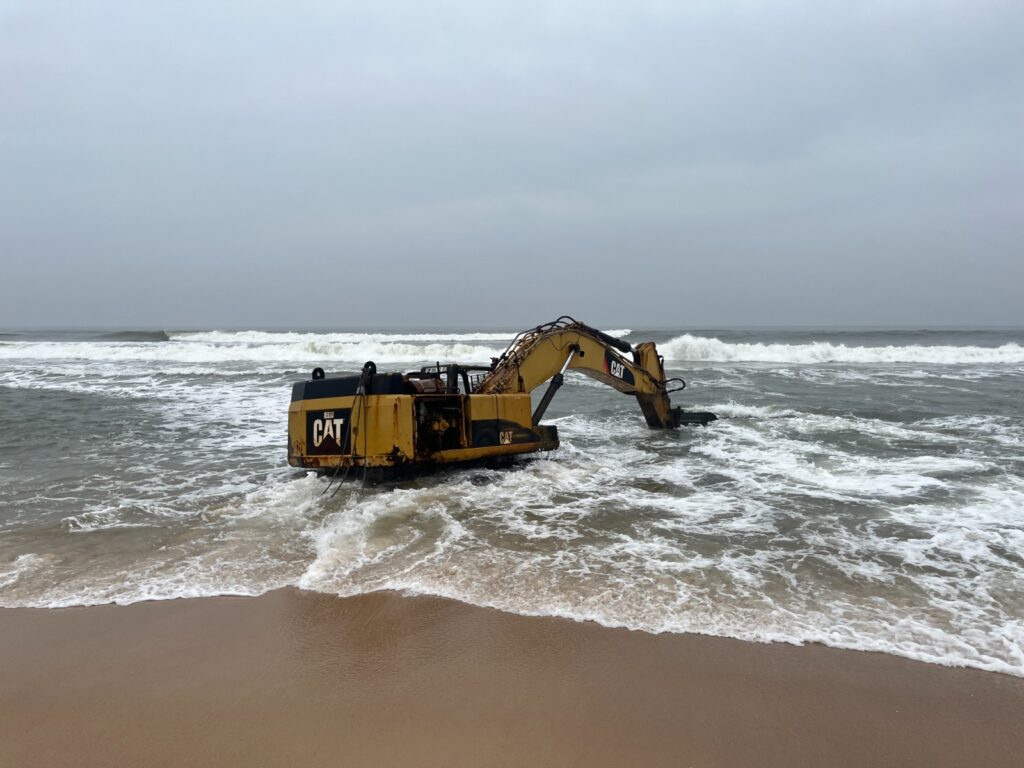
Where we would run the day after!
Known for its powerful surf, golden sands, and dramatic waves, it’s a favorite spot for locals and visitors seeking a natural beach experience.
While not ideal for casual swimming due to strong currents, it is popular for surfing, sunsets, and beachside relaxation.
We saw surf clubs and even a very daring local venturing into its dramatic waves.

The area remains relatively unspoiled, offering a raw and rugged contrast to the industrial port city nearby, which I found very appealing.
Petroleum in Congo-Brazzaville
When visiting Côte Sauvage, we saw, right on the beach, a “Club Petrolier ENI”. It looked like a Beach Club, but the fact that it seemed to belong to a petrol company surprised me.
Indeed, ENI is an Italian petrol company.
This sparked a conversation with our guide, Nel, about how the foreign petrol companies (specially the French Total) operate here. The Republic of Congo is very rich in oil, but, according to him, only the government benefits from it.
So later I did a little bit of research about the matter and I found out that indeed the Republic of the Congo is one of sub-Saharan Africa’s major oil producers, with petroleum being the backbone of its economy.
Oil accounts for over 70% of government revenue, nearly all exports, and a significant portion of GDP. Most of the country’s oil production is offshore, in deep-water fields off the coast near Pointe-Noire.
Foreign companies do dominate the oil sector in Congo-Brazzaville, bringing in capital, expertise, and technology.
Exactly as Nel mentioned, the French TotalEnergies is the largest foreign operator in the Congolese oil sector. It operates major offshore fields, most notably the Moho-Bilondo field, the country’s largest deepwater oil development.
But… despite abundant oil wealth, poverty and inequality remain high, and revenues have often been mismanaged or affected by corruption.
As Nel also said, it does look like the government faces pressure to diversify the economy and invest oil profits in public services.
Pointe Noire Market
On our second day, we visited the huge, vibrant, chaotic and amazing Pointe Noire.

We were no strangers to African markets, but, still, it is always entertaining to walk around and let yourself be surprised by what you see.
Everything is being sold: from plastic toys to dead chickens, from sandals to cooking spices, from football t-shirts to washing machines.
The ‘public transport’ in the form of small vans and taxis painted with geometric designs, impossible stripes resembling thunder, like in the best of maverick driver movies. I saw one taxi in which five very big women managed to sit down in the rear seat!
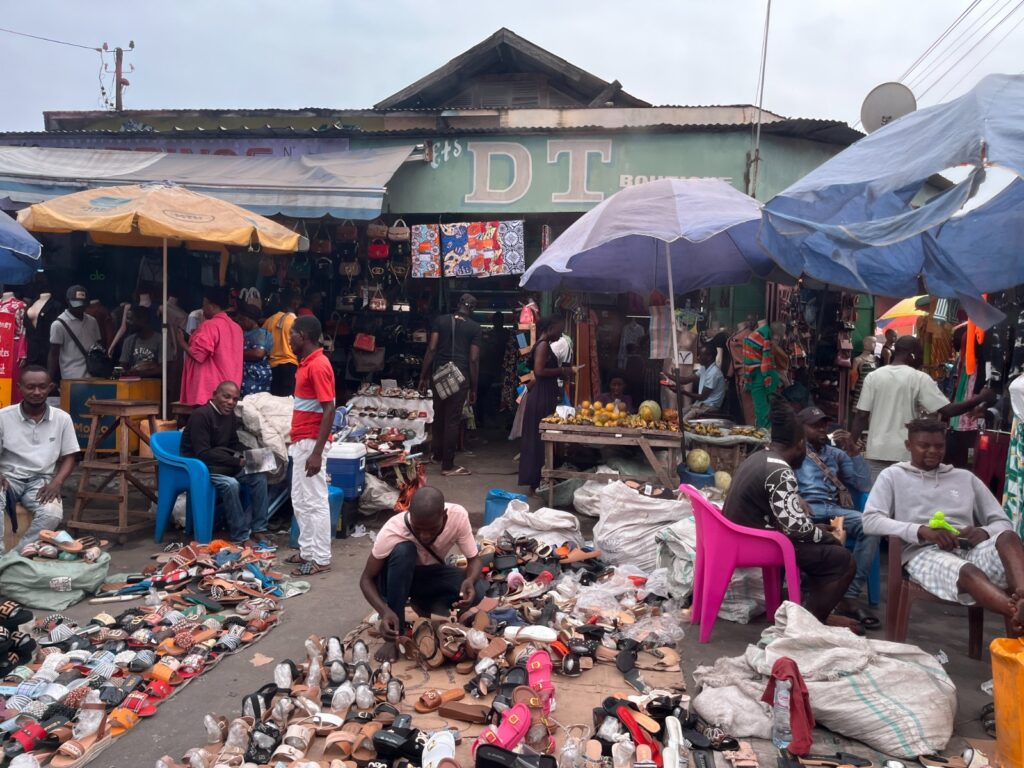
And many young guys with a comb in their hair! First time I had seen this, but apparently was a thing in the 70s (as this Quora post indicates) and it is now returning to Africa:
“Think ‘70s era Earth Wind, and Fire.
Those Afros were combed with pick combs. And the men were constantly picking them out so that they stood up tall. When an Afro is tall enough it won’t stay up, it will gradually fall. It seemed like every few minutes men had to pick them out.
I think because those Afros were constantly being combed, some men just left the comb in the hair out of convenience, but it became a fashion statement and having a pick with a cool design like the Black Power fist just added to the look”
Songolo
We also ventured a little further, to reach Songoló, where according to Nel “we were going to see fishermen”.
Nel’s sentence doesn’t really cut it.
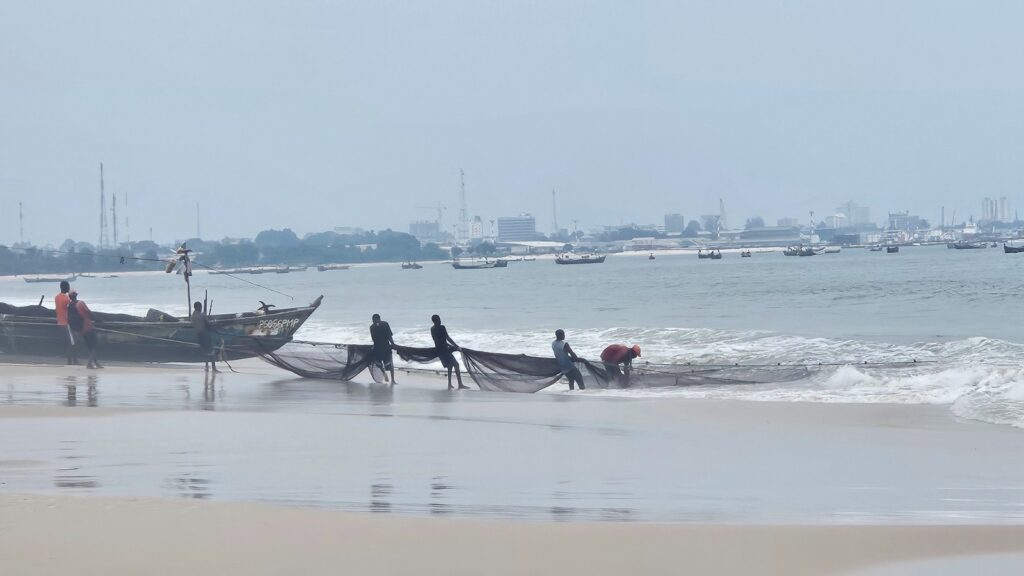
It was more than seeing fishermen. It was a unique moment, one of those who made love to travel to unusual places where tourists do not visit often.
There were no tourists on the endless beach. A guy was cleaning fish while seagulls swarmed eagerly around. Lost in the distance, wrapped in humidity, a few wood fishing boats were resting in a row on the sand. They had finished their day: a few guys were collecting their fishing nets.
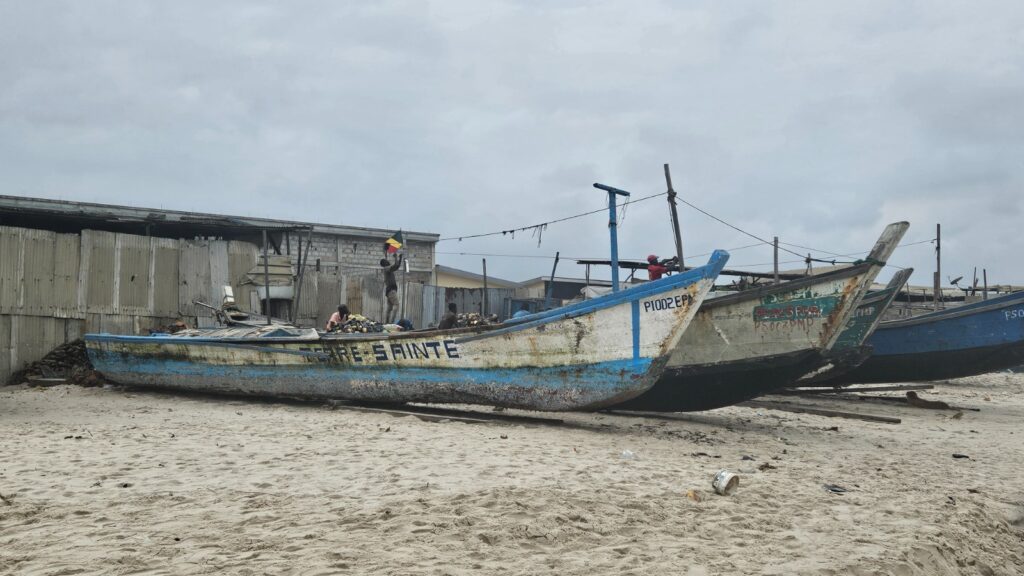
It was real, it was not a show for tourists. I dwelled on every sensation: the smell of fish, the sound of the waves while it hit the posts below a doc under construction.
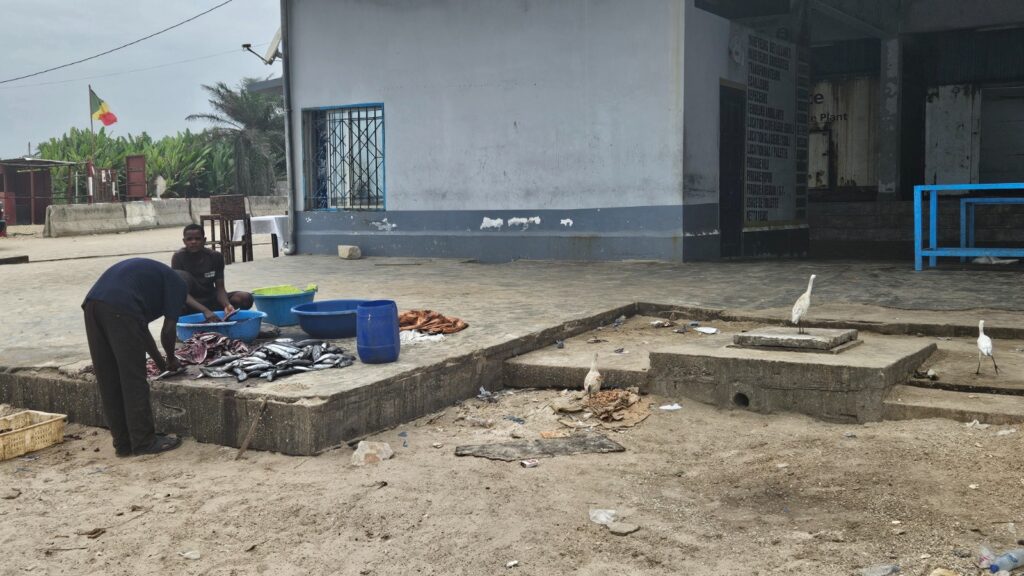
Oh, and in the background, blurred by this humid fog, the super port with cranes, and the outlines of the city’s buildings. It was Pointe Noire in the distance.
The striking Gorges of Diosso
The main reason to visit the Republic of the Congo was to see the Gorges of Diosso.
And we were not disappointed!
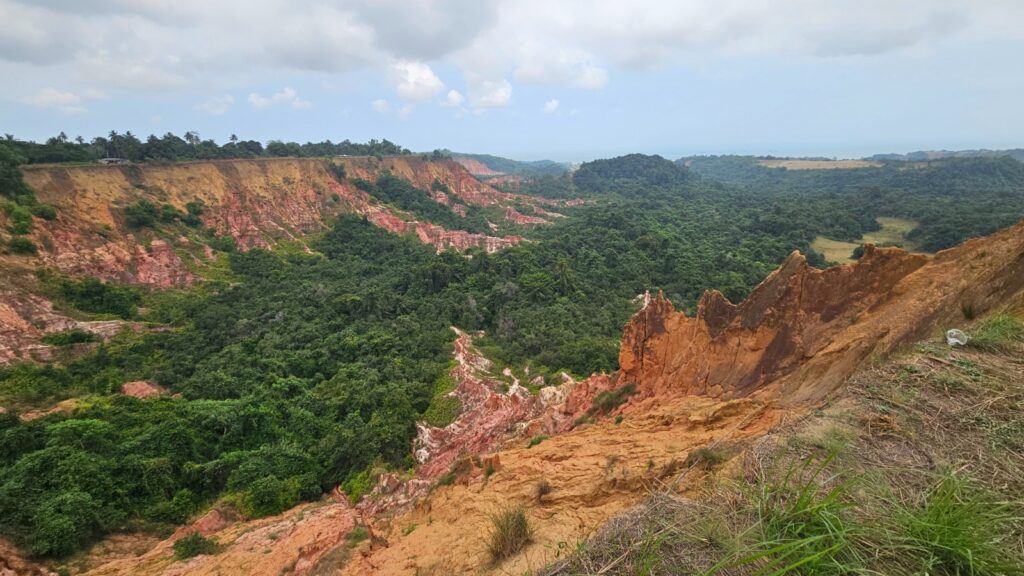
The gorges of Diosso are a striking natural formation renowned for their dramatic beauty and geological significance. Often referred to as the “Grand Canyon of Congo,” these gorges feature towering cliffs, layered red and ochre earth, and lush vegetation clinging to the slopes.
When we visited, there were no other tourists. In fact, there was nobody, which made the experience even more unique.
Funnily enough, though, after we spent fifteen minutes there, a few locals appeared. That is sometimes the case in Africa. Locals appear all of a sudden and look at you with a grim of disgust in their faces. Sometimes they ask for money, sometimes they try to sell you something, sometimes they just murmur something in their own language that doesn’t sound nice.
It didn’t really matter. The views were wonderful enough so as not to care.
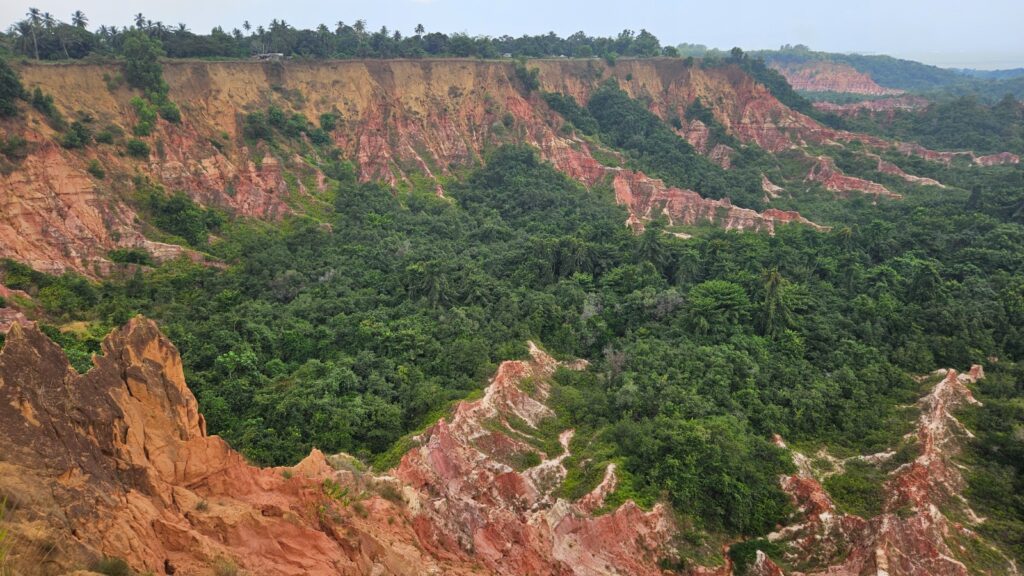
The landscape has been shaped over millions of years by natural erosion processes, creating a breathtaking contrast between the arid rock faces and the surrounding greenery.
We also learnt that, beyond their visual appeal, the Gorges of Diosso hold cultural and historical significance for the local Vili people, who consider the area sacred. The site is often associated with ancestral spirits and traditional stories passed down through generations.
Ma Ngoma
One traditional Vili story about the Gorges of Diosso tells of a powerful ancestral spirit named Ma Ngoma, believed to dwell within the depths of the gorges. According to legend, Ma Ngoma was once a wise and revered healer who lived in a prosperous Vili village near the cliffs. When foreign invaders arrived, threatening the land and its people, Ma Ngoma called upon the spirits of the earth for protection. In response, the ground split open with a thunderous roar, creating the deep gorges and swallowing the invaders whole.
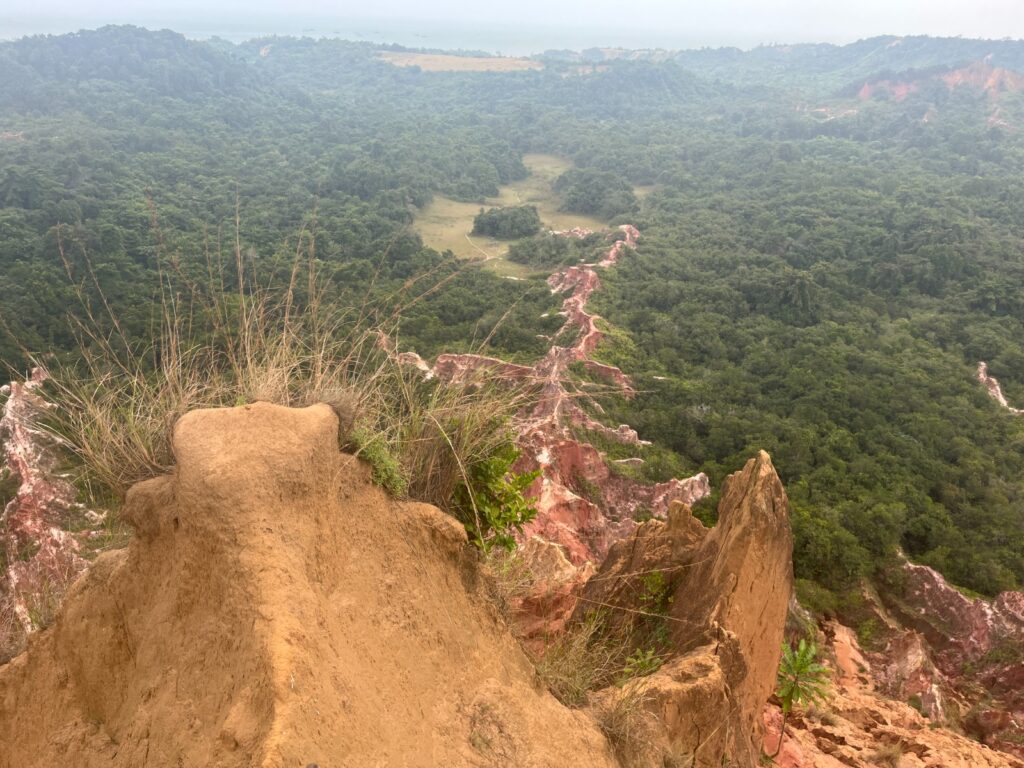
The Vili people believe that the gorges are a sacred mark left by the ancestors—a reminder of their strength, wisdom, and the enduring connection between nature and the spirit world. Even today, some locals leave offerings at the edge of the cliffs to honor Ma Ngoma and seek guidance or protection.
Yuyu
During our time in Africa we heard often about “yuyu”. From Djibouti to Ethiopia to Ruanda or Uganda, our guides lowered their voices when speaking about it.
In Congo-Brazzaville, our guide explained that it is very common. “Yuyu” is a term often used in popular speech to refer to sorcery, witchcraft, or mystical powers—usually with a negative or fearful connotation.
Rooted in traditional beliefs and spiritual practices, yuyu is associated with invisible forces believed to influence events, health, or relationships, often in secretive or harmful ways. While the word can be used playfully or figuratively in casual conversation (e.g., “He got rich too fast—maybe he’s into yuyu”), it often reflects real cultural concerns about the presence of the supernatural in everyday life.
The concept of “yuyu” in Congo-Brazzaville originates from Central African traditional belief systems, particularly those of the Bantu-speaking peoples, such as the Kongo, Vili, Téké, and Lari ethnic groups. These groups have long held worldviews in which the physical and spiritual realms are closely interconnected. In this context, “yuyu” refers to spiritual or mystical forces—sometimes protective, but often feared for their association with sorcery, curses, or manipulation of unseen energies.
Belief in yuyu cuts across urban and rural settings and can influence how people interpret misfortune, illness, or sudden success. Some people may consult traditional healers or spiritualists to counteract or protect themselves from yuyu, while others may avoid certain individuals or behaviors out of fear of being “bewitched.” We heard our guides talking with other locals (a cook or a guide) and mention it.
Indeed, despite modernization, these beliefs remain deeply woven into the social fabric, often existing alongside Christianity or other formal religions. Yuyu is not just folklore—it shapes community dynamics, justice practices, and personal relationships in subtle but powerful ways.
The streets
The streets in Pointe Noire and its suburbs were the typical African human landscape that we had seen in other countries and that truly fascinates me.
People going back and forth, women proudly walking carrying all kinds of stuff on their heads, kids in school uniforms running around, the most extravagant items being sold in shops painted with curious drawings, stalls with plenty of very good looking fruit, piles of tires in random places…
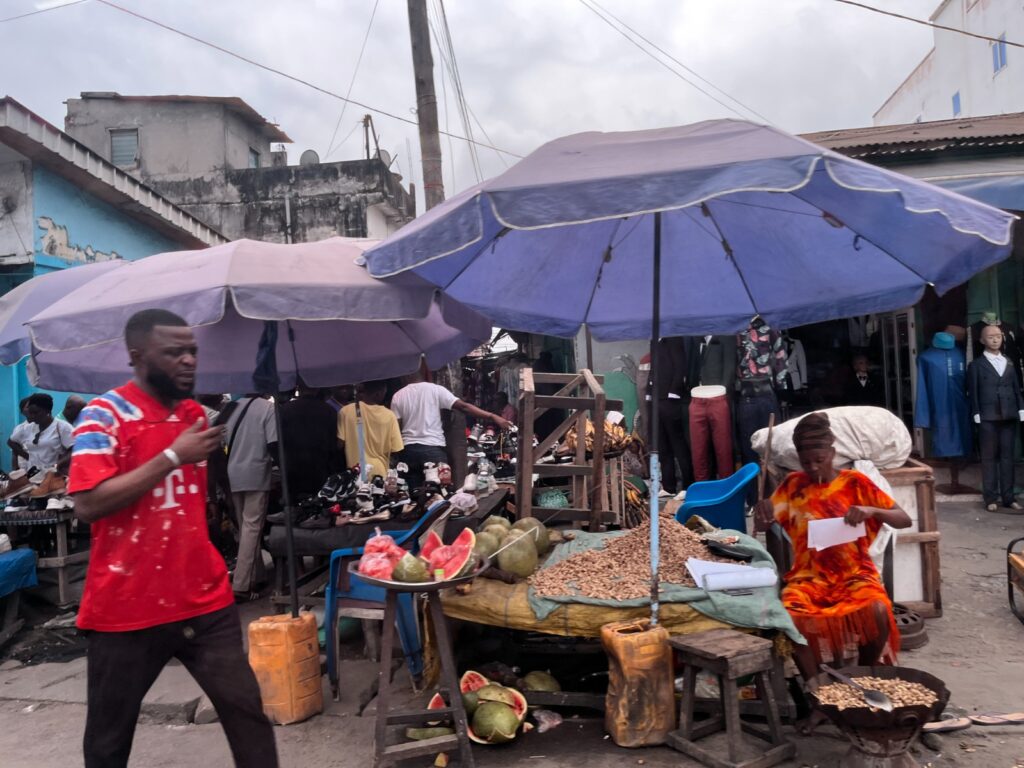
I never get tired of looking at them, though.
I always find unusual sights, surprising ads, incredible things being carried in vehicles or in bicycles.
On our way to Gorges of Diosso, I made a list of the items that were sold in the streets. I saw brooms, metal doors (a super classic!), buckets, sinks, flip-flops, bananas, flowery dresses, T-shirts, plastic chairs, potatoes, ovens, a children’s slide, beer crates, fans, soda cartons, tomatoes, sneakers, light bulbs, and a doctor’s uniform, showed even with a stereoscope around his neck.
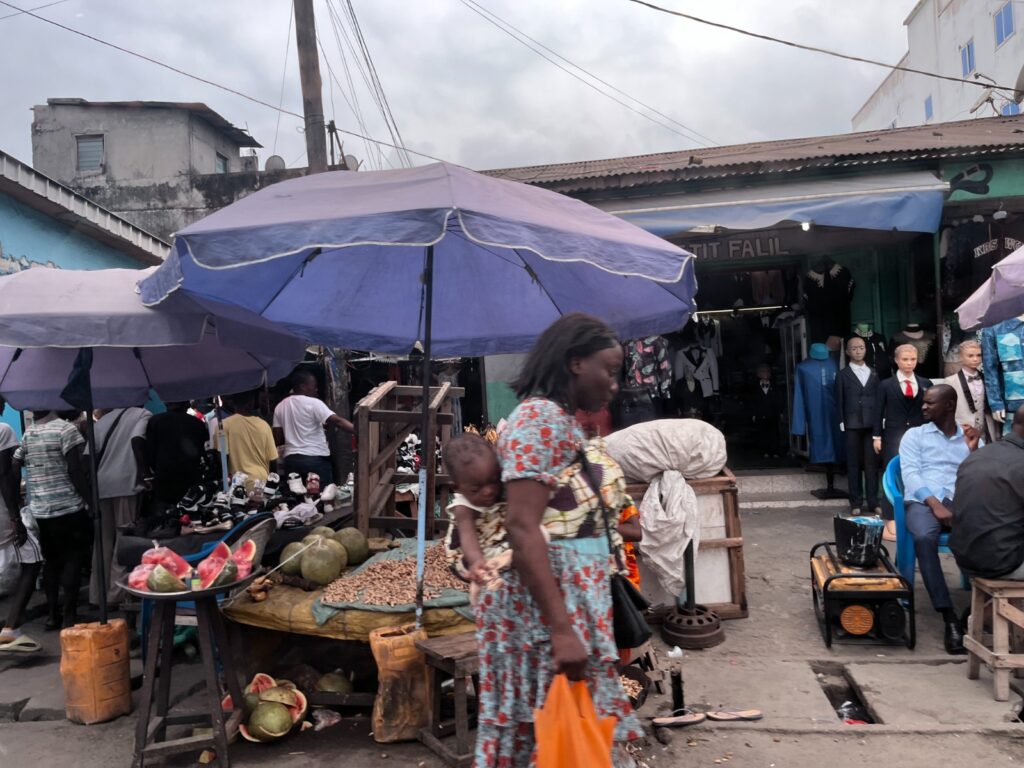
I also looked at the graffiti drawn on the shops’ walls. Washing machines, cow heads, croissants, hairstyles… in schools, children depicted studying or in front of the computer, or cartoons of Mickey Mouse and Winnie the Pooh… I even saw a drawing of a grave in a funeral home!! And, on the walls of a military base called “18 de Julliet”… a tank!! 😂
🏃♀️ The Run🏃♂️
I enormously enjoyed the 6.5k run we did on a hot but foggy morning of June in Pointe Noire.
So much, the day after we repeated and ran it again! The only difference was that the first day was a bank holiday and the second day, the start of a working day.
Run logistics
The first day we didn’t wake up too early to avoid the traffic since it was a bank holiday – Reconciliation Day.

So we ran from 7:30 to 8:30am in the morning and, indeed, there was little traffic and little pollution and we ran comfortably.
It was a little hot and humid but not too bad. We didn’t carry water with us, and there were no water drinking fountains along the way, but it was not necessary.
The Railway Station
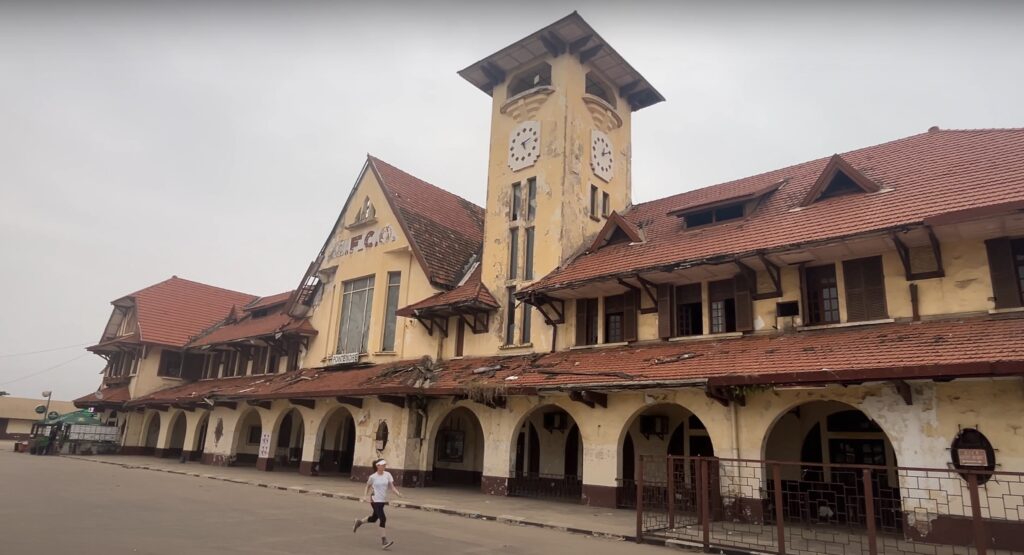
We first headed to the old railway station, which had fascinated me the day before.
It was 1 kilometer away from our hotel and we crossed paths with the funny looking taxis and public service mini vans with guys inside shouting out loud.

Some of them honked and shouted at us “Mudénlé”, which means “White man” (as a drawing in our hotel hall taught us 🙂):
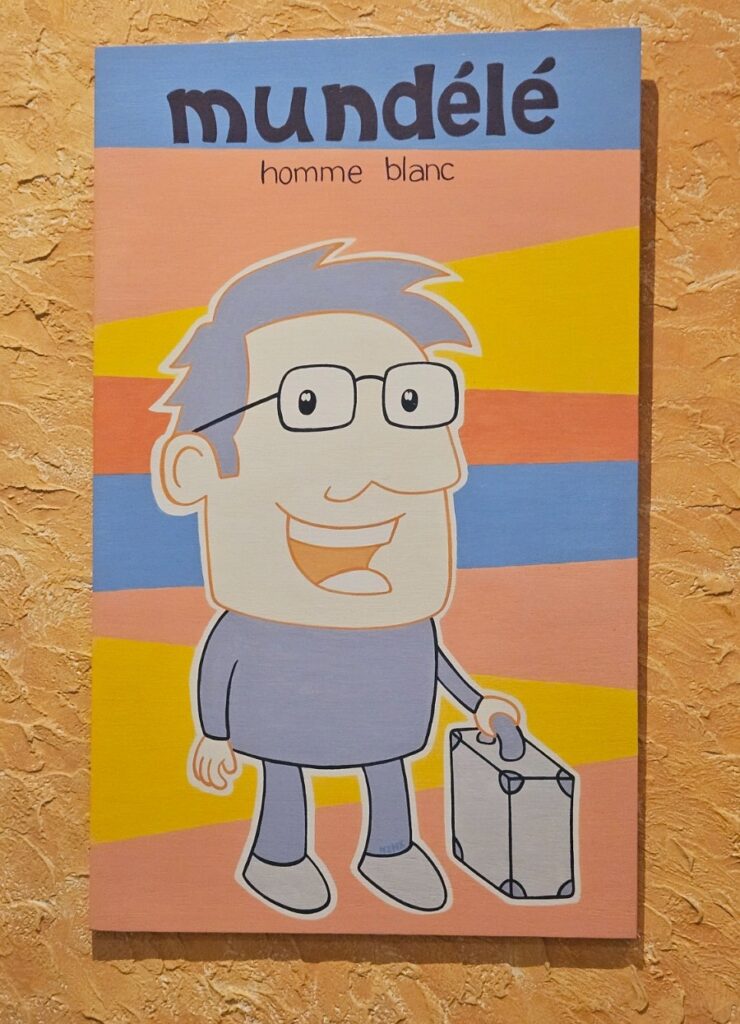
But we also encountered some other runners, so we were not really an exotic sight.
After running on the seemingly abandoned tracks (note – the tracks are not really abandoned, they are in use for cargo!), we subsequently headed for the beach.

Côte Sauvage
Running on the beach was fantastic.
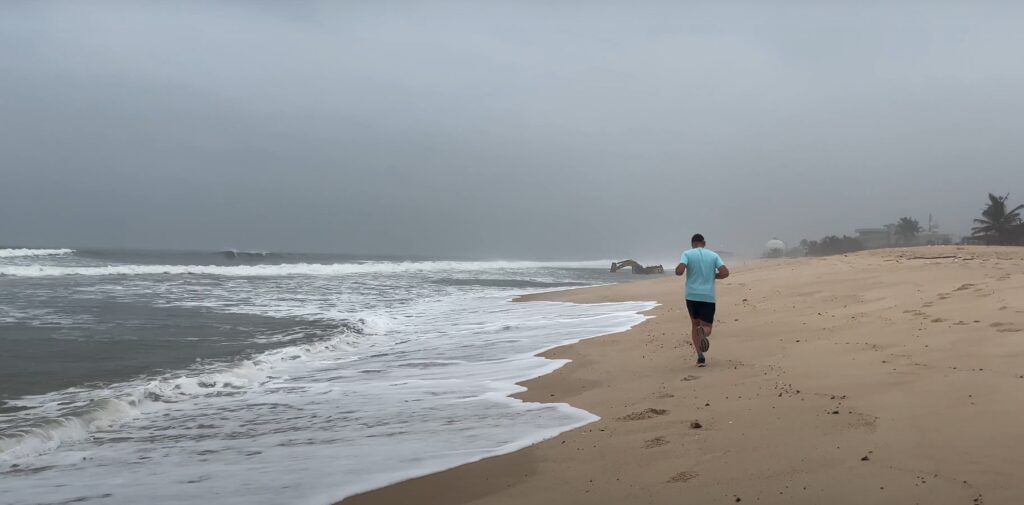
At that time of the day there were only a few locals power-walking or doing exercises. But in general the endless white sand was empty of people and added to the “wild coast” sensation.
The endless sand, dotted with palm trees, was enveloped in a damp mist, giving it a mythical and evocative appearance. The palm trees were barely visible in the distance. The high waves broke a few meters from the shore, offering a resounding spectacle. The name “wild coast” couldn’t have been more appropriate!!!
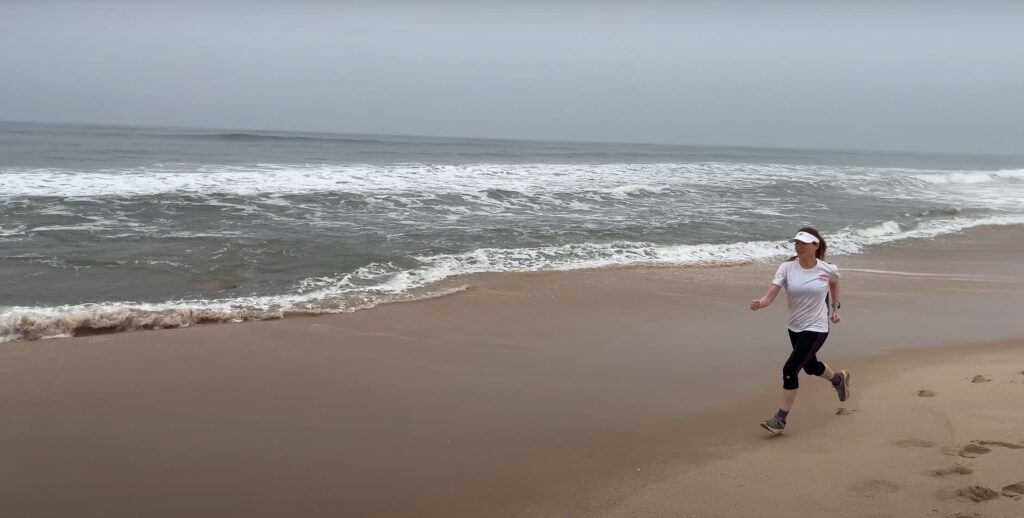
Technically, what we were seeing was a coastal fog caused by condensation of humid air over the ocean, also known as marine advection fog. But to me it seemed like nature’s way of warning potential intrepid travelers of the dangers of the place.
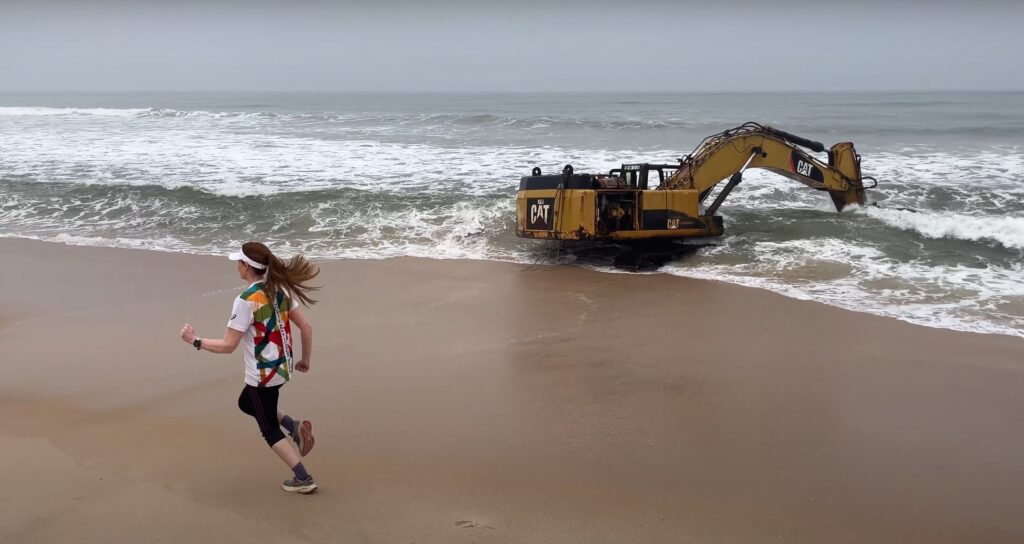
A testimony to it was… a massive excavator stuck in the water!
It was an unexpected image that, together with the vision of the industrial port on the horizon, reminded me that Pointe Noire is an oil hub, not a tourist spot.
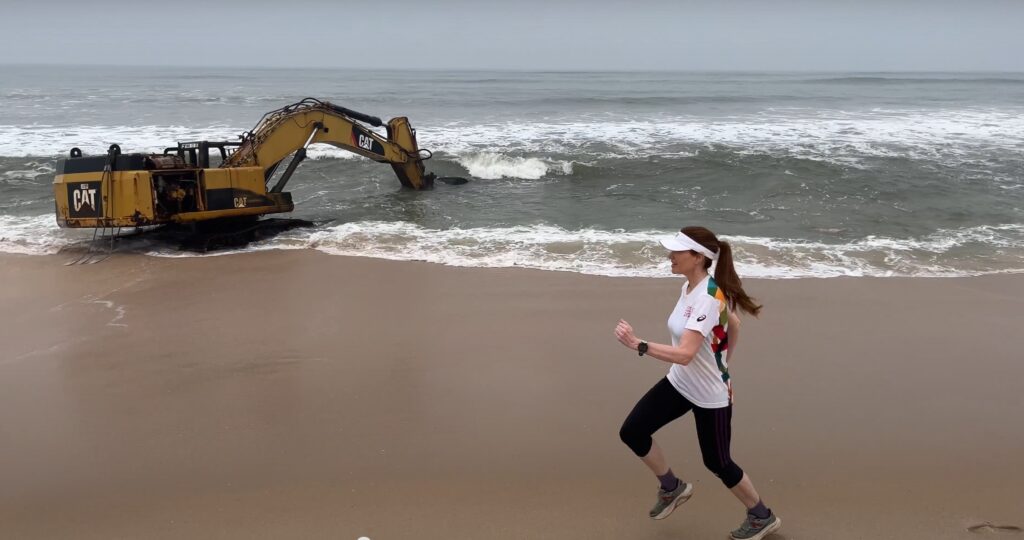
Not easy to run – Jacques Bouiti avenue was the place to run!
However it was not easy to run on the beach. The shore had a very steep slope, which made running alongside the water really difficult.
Hence why a lot of locals were running or doing exercises in the wide Jacques Bouiti avenue.
I saw a large group of locals who didn’t seem very fit, shaking their hips, led by a trainer with a big belly and a good-natured smile. In contrast, a few meters away, a group of about five people were lying on the floor sweating, doing sit-ups while a trainer, this one super fit, yelled at them in French to do 10 more! I gave them a “Bravo!” for their efforts as we ran past.
A stop to get a taste of the wild coast!
We got to the part of the coast where the “Casa Papaya” restaurant where we had lunch the day before.
It was not too muddy as it had not rained during the night. The day before we saw a taxi stuck in the mud right here, but we could pass by without getting our running shoes dirty!
Here Roger decided to take an adventurous bath in the wild coast! Why not?
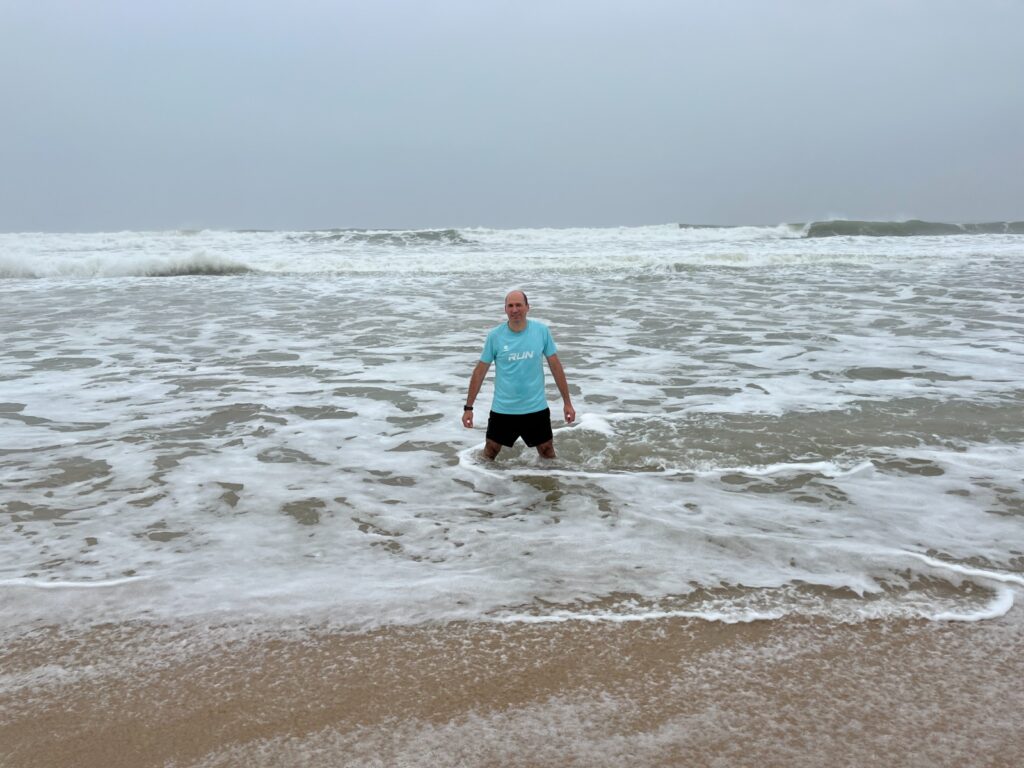
I advised him not to go too far because along the Côte Sauvage (Wild Coast) near Pointe-Noire, one of the most notable geographical features is how quickly the sea becomes deep just offshore. This steep continental shelf drop-off means that the deep waters are very close to the coast.
The rapid deepening of the sea off the Côte Sauvage is a natural advantage that supports Pointe-Noire’s role as a major deepwater port, helping it handle large ships efficiently and remain a strategic economic and shipping center in West-Central Africa.
Final 2 kilometers – Ngueli Ngeuli Avenue
For the final 2 kilometers, we took a detour along Avenue NN.
We re-entered the semi-deserted city. Something that really caught our attention was a guy selling painted sculptures in the street.
I had seen him the day before from our car, but at 8am he was already working on his art.
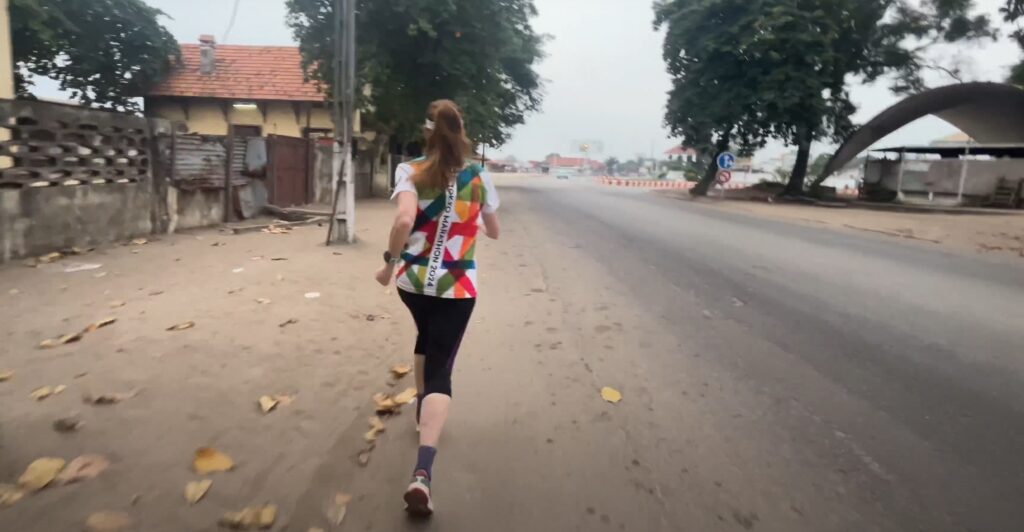
The sculptures were really really cool, and ranged from Virgin Marys to
The fact that they were painted looked to me extravagant.
Funnily enough, this was something I had also seen in official sculptures of big dignitaries in Burundi.
Finally, very close to our hotel, we crossed the train tracks again. Near them, there was a flower shop that gave the tracks, already half-covered in grass, an unexpectedly bucolic appearance.
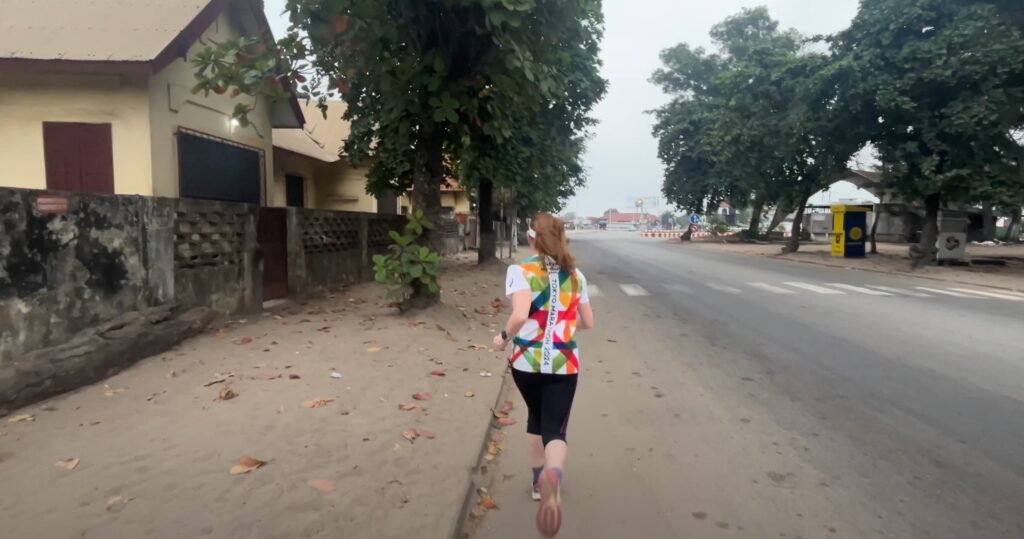
Having completed more than 6kilometers, we finished our run right in front of our hotel, ready to have breakfast!
Second run – the city was waking up to a buzzing day of work!
The second day we started earlier, to avoid the possible traffic.
It was definitely the right thing to do, since when we finished, around 7:30am, the streets were already busy and the taxis and vans around made it a little less enjoyable.
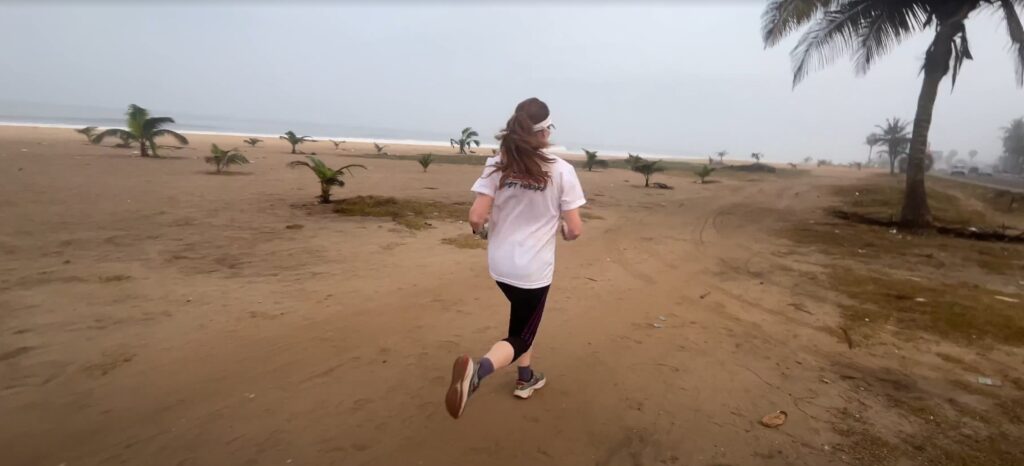
We also got the opportunity to see locals going back and forth to work, buying food in the street stalls.
Next to the railway station, a couple of stalls had a fire in a barrel stove going on, where busy women were cooking something to later sell.
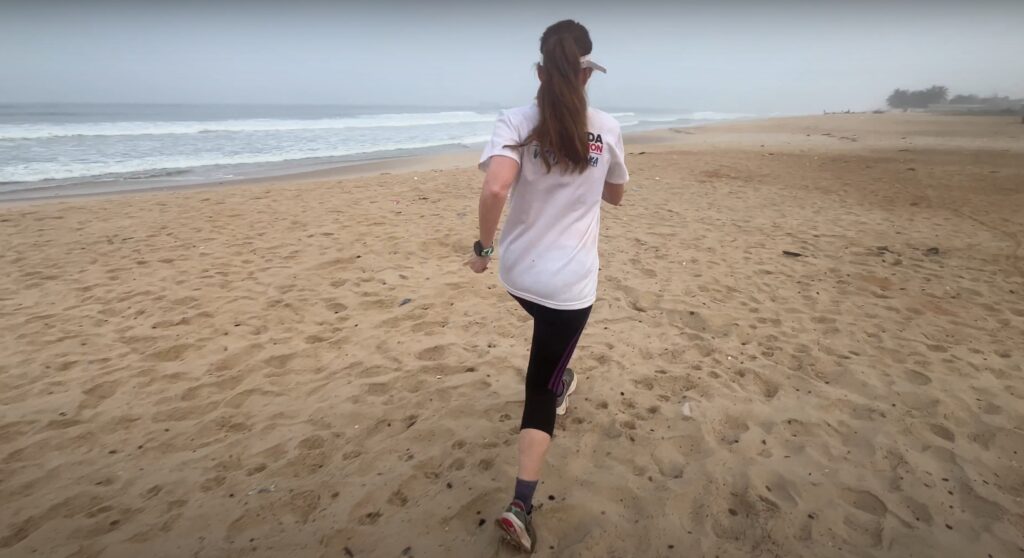
I was almost run over by a super big African lady with hair bleached with a “Naples yellow” colour. Yes, I looked it up the exact tone in the internet 🙂
I was very impacted by the colour and the size of the hair, which probably was a wig. And I remembered our Uganda’s guide, Letitiah, bitching about how “women in Congo bleach their hair” 😂😂
The beach was still empty, though. It was not easy but again we ran a long stretch on the sand because the atmosphere, with the humid fog and the roaring waves, was unique.

When we finished, I mentioned to Roger: “you cannot buy these experiences with money”. I was so energized and so grateful to be able to run in such a place! A very special run indeed 🥰
🍜 Carboloading 🍝: What to eat in Pointe-Noire if you are a runner
Two restaurant recommendations
Here are two restaurant recommendations, very different from each other.
For our first lunch in Congo, we opted for the fashionable “Casa Papaya” after a recommendation by our guide.
The place was very cool, right on the beach!
The food was tasty and I specially recommend its “Virgin Mango Colada” and “El diablo” cocktails 🥰
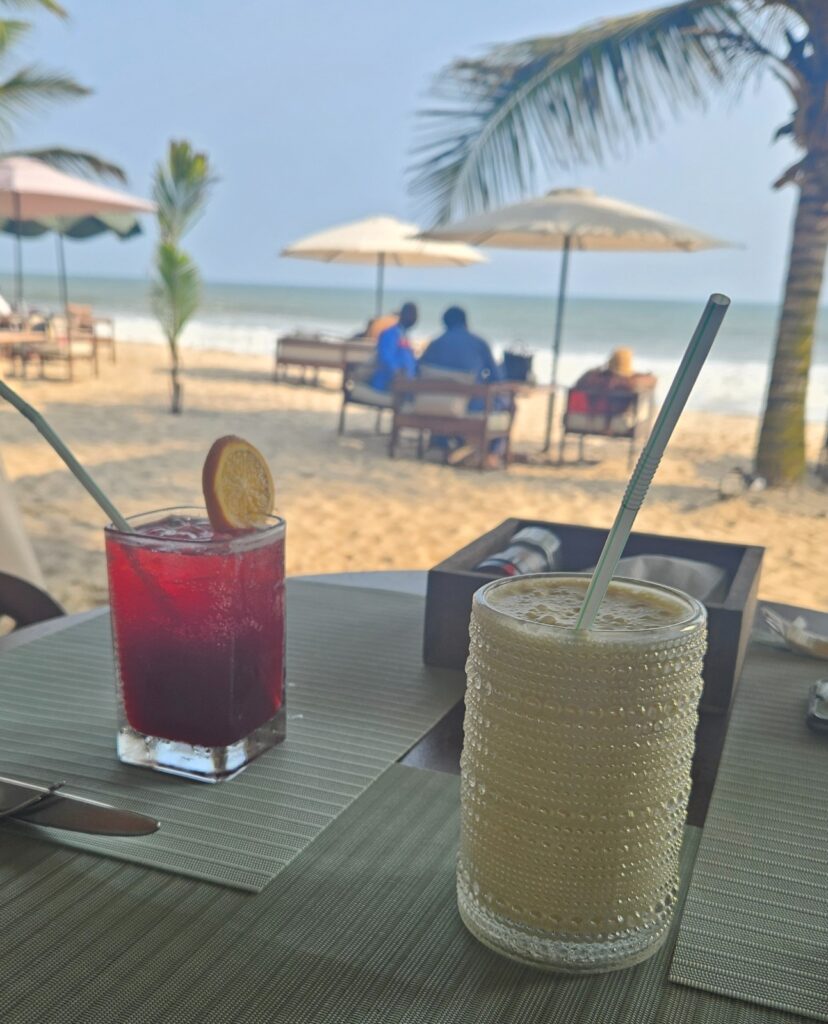
Warning: it is not cheap! It was full of “beautiful people”, looking very relaxed and very posh. In fact, its Instagram looks like a fashion show!
So, the day after we opted for something different, more local, a restaurant near our hotel full of locals. “Si! Bon!” It was cheaper and the food was also very good.
In most places in Africa the dishes are made with very fresh ingredients, so it is difficult to get it wrong.
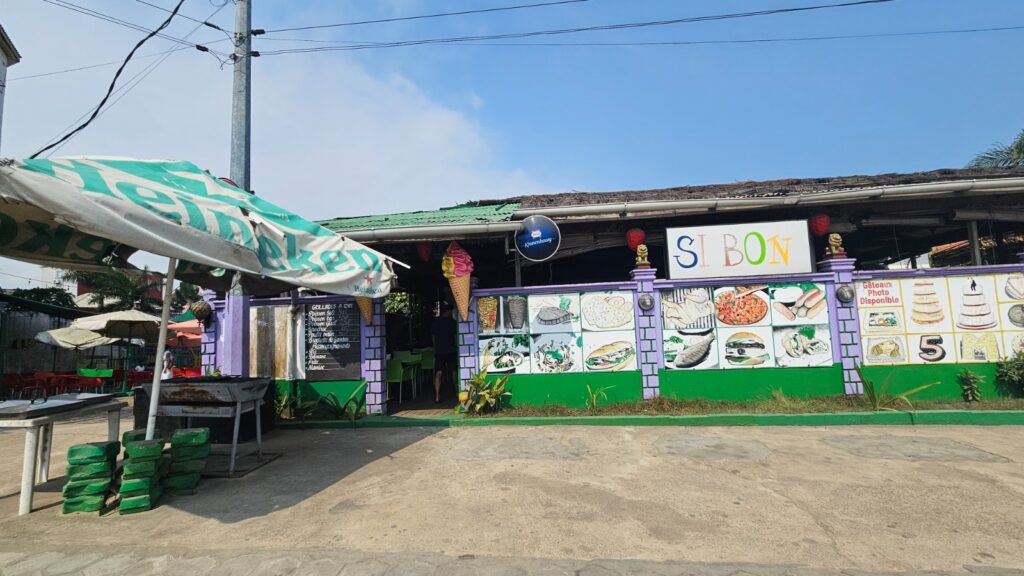
The only thing they had in common (like everywhere in Africa) is that you cannot rush it. The places take time to arrive. It is often said that time has a different dimension in Africa, and, in the case of eating out, that’s definitely the case.
Carboloading!
The Republic of the Congo has a rich and diverse cuisine influenced by Central African traditions, featuring cassava, plantains, fish, and meats. Below are three high-carb dishes to fuel your run and three high-protein dishes for recovery after exercise.
🏃♂️ 3 High-Carb Congolese Dishes (Pre-Run Fuel) 🍛
These meals provide sustained energy for endurance.
1️⃣ Chikwangue (Cassava Bread) 🍞
- A traditional dish made from fermented cassava wrapped in banana leaves and steamed.
- 🔥 Why it’s good for running?
- Rich in complex carbohydrates for slow-releasing energy.
- Light and easy to digest before exercise.
2️⃣ Fufu (Cassava or Plantain Dough) 🍌
- A smooth, starchy dish made from cassava, yams, or plantains, served with soup or stew.
- 🔥 Why it’s good for running?
- Packed with starches for long-lasting energy.
- Helps maintain hydration when eaten with soup.
3️⃣ Makemba (Fried or Boiled Plantains) 🍌
- Sliced ripe plantains, either boiled or deep-fried.
- 🔥 Why it’s good for running?
- High in carbs for fast and sustainable energy.
- Contains potassium, which prevents muscle cramps.
💪 3 High-Protein Congolese Dishes (Post-Run Recovery) 🍖
These meals help rebuild muscles and promote recovery.
1️⃣ Moambe Chicken (Poulet Moambe) 🍗
- A famous stewed chicken dish cooked in palm butter (moambe), peanuts, and spices.
- 💪 Why it’s good for recovery?
- High-quality protein from chicken helps muscle repair.
- Healthy fats from palm butter aid recovery.
2️⃣ Ntaba (Grilled Goat Meat) 🐐
- Marinated and grilled goat meat, often served with onions and spices.
- 💪 Why it’s good for recovery?
- Goat meat is rich in protein and iron, which aids in muscle recovery and oxygen transport.
3️⃣ Maboke (Steamed Fish in Banana Leaves) 🐟
- Fish (usually tilapia) seasoned with spices, wrapped in banana leaves, and steamed.
- 💪 Why it’s good for recovery?
- Fish provides lean protein and omega-3 fatty acids, reducing inflammation.
- Cooking in banana leaves retains nutrients without added fat.

Map
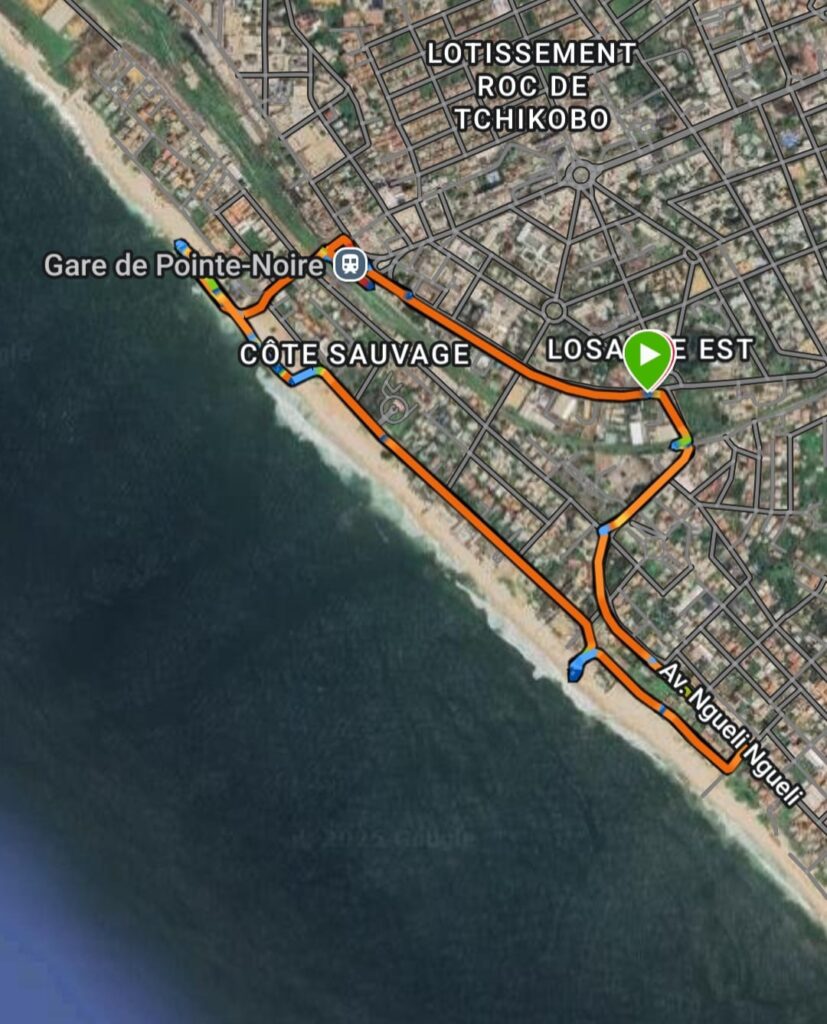

Useful information
🏃 Run along the shore of the Cote Sauvage in Pointe Noire, Republic of the Congo.
👟 Urban: bring shoes for asphalt: on the sand you can run barefoot, it is clean enough.
✅ Wild, spectacular beauty, and the bonus of some unexpected sights.
✅The avenue is popular with runners, wide enough and not too much traffic during the early hours of the day.
⚠️ It is difficult to run on the beach as the sand has a steep inclination.
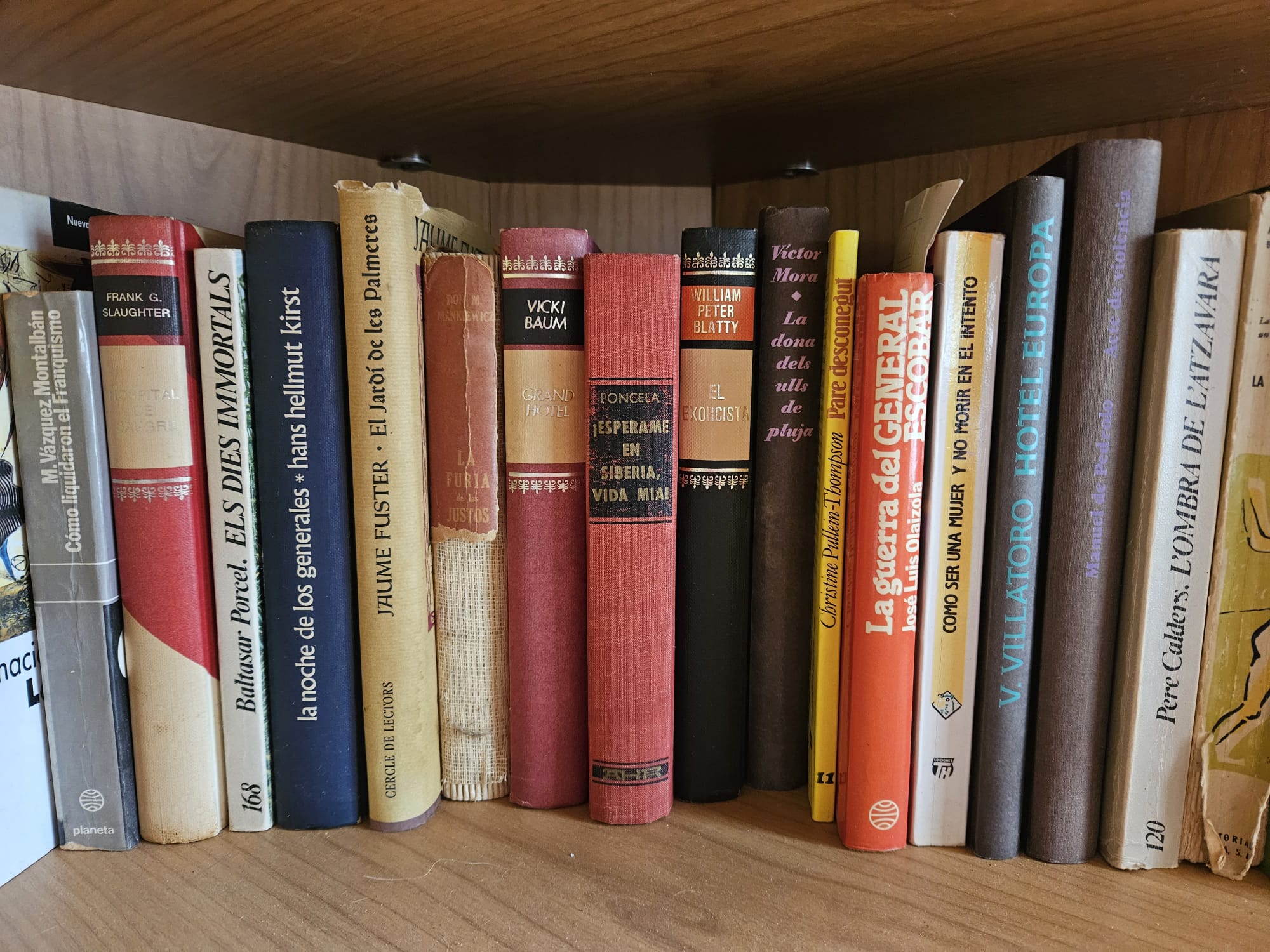
One book
For the usual book section, since the river Congo also runs through Republic of Congo (in fact, it is the border!) you can also check this blog post and this one which feature some of my favourite books ever.
But for Point-Noire, this one is amazing!
“Broken glass” by Alain Mabanckou
An irreverent, allusive, scatalogical, tragicomic masterpiece that centers on the patrons of a run-down bar as they try to document the details of their lives in a country that appears to have forgotten the importance of remembering.

Plot Summary:
In Republic of the Congo, in the town of Trois-Cents, in a bar called Credit Gone West, a former schoolteacher known as Broken Glass drinks red wine and records the stories of the bar and its regulars for posterity: Stubborn Snail, the owner, who must battle church people, ex-alcoholics, tribal leaders, and thugs set on destroying him and his business; the Printer, who had his respectable life in France ruined by a white woman, his wife; Robinette, who could outdrink and outpiss any man; and Broken Glass himself, whose own tale involves as much heartbreak, squalor, disappointment, and delusion.
